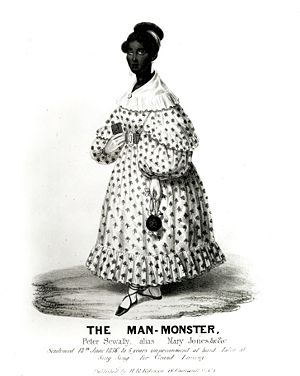Difference between revisions of "Peter Sewally - Mary Jones, June 11, 1836"
| Line 3: | Line 3: | ||
by Jonathan Ned Katz (used with permission from his book ''Love Stories'')<ref>Reproduced with permission from Jonathan Ned Katz, ''Love Stories: Sex Between Men Before Homosexuality'' (Chicago: University of Chicago Press, 2001), pp. 880-87. Copyright by Jonathan Ned Katz. Not to be reproduced for commercial purposes without permission from Katz.</ref> | by Jonathan Ned Katz (used with permission from his book ''Love Stories'')<ref>Reproduced with permission from Jonathan Ned Katz, ''Love Stories: Sex Between Men Before Homosexuality'' (Chicago: University of Chicago Press, 2001), pp. 880-87. Copyright by Jonathan Ned Katz. Not to be reproduced for commercial purposes without permission from Katz.</ref> | ||
| − | [[Image:Maryjonessewalley.jpg|right| | + | [[Image:Maryjonessewalley.jpg|right|300px|Mary Jones, "Man Monster, Holding place for color image.]] |
Revision as of 16:03, 27 March 2008
The "Man Monster"
by Jonathan Ned Katz (used with permission from his book Love Stories)[1]
About ten o’clock on the night of Tuesday, June 11, 1836, in New York City, a master mason named Robert Haslem, a white man was walking home after a liaison with a woman he had picked up earlier that evening, as the New York Herald later reported.
On Bleeker Street, Haslem met a black woman, Mary Jones, dressed "elegantly and in perfect style," with white earrings and a gilt comb in her hair.<N18> The Herald's rival, the New York Sun, added that Mary Jones also went by the names "Miss Ophelia:' "Miss June:' and "Eliza Smith."
Haslem or Jones initiated a conversation-the newspapers differed. Haslem then asked Jones, "Where are you going my pretty maid?" and volunteered to go with her.
Before they set off "on this tour of pleasure," said the Herald,) she "lovingly threw her arms around him and strained him to her heart." Then, "these delicate preludes having ended, they proceeded onwards, until they arrived at an alley in Greene Street [known then as a site of prostitution], which having entered *****" Here, a se-ries of asterisks in the Herald's report suggest, as clearly as the missing words, a sexual act.
Haslem and Jones "had some further conversation" in an alley, said the more reticent Sun, "where the prisoner again had his arms about complainant."<N19> Afterward, on his way home, according to the papers, Haslem discovered that his wallet and ninety-nine dollars were missing. In their place he unaccountably found the wallet of a man he did not know, with a bank order for the then large sum of $200.
Haslem sought out the man who, at first, denied ownership of the wallet, but then admitted he had had his pocket picked the previous evening, under the same circumstances as Haslem. He had been "too wise," how-ever, "to expose himself" by reporting the theft to the police.
Next morning the determined Haslem confessed his story to a Constable Bowyer who, that evening, set out to find Mary Jones. Around midnight, on the Bowery, Bowyer passed a black woman and, according to the Herald, "thinking that this might be the one he sought" (and assuming the right to his gaze), looked at her face and "made up his mind that he was right."
"Where are you going at this time of night?" he asked. "I am going home, will you go too?" she answered. He agreed, and "she conducted him to her house in Greene Street, and invited him in."
He declined, "with great regret," but later walked her to an alley where she asked him, as the Herald put it, "to reenact the scene of the previous evening" with Haslem. She then "proceeded to be very affectionate:' and Bowyer arrested her.
"A tussle ensued:' the Sun reported, during which the prisoner allegedly took two wallets from her bosom and threw them away. One turned out to be Haslem's. On the way to the watch house, Jones al
END PAGE 81
- ↑ Reproduced with permission from Jonathan Ned Katz, Love Stories: Sex Between Men Before Homosexuality (Chicago: University of Chicago Press, 2001), pp. 880-87. Copyright by Jonathan Ned Katz. Not to be reproduced for commercial purposes without permission from Katz.
